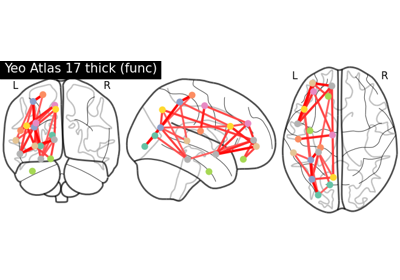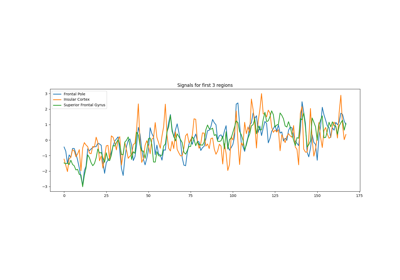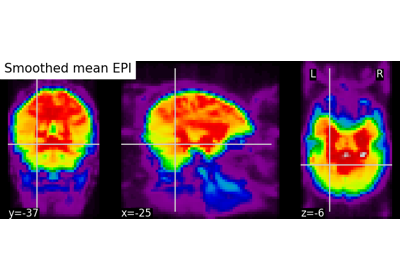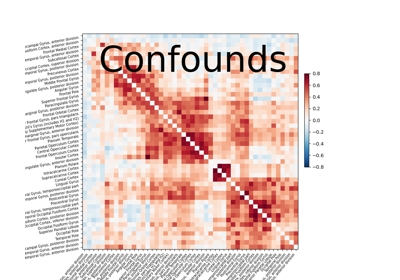Note
This page is a reference documentation. It only explains the class signature, and not how to use it. Please refer to the user guide for the big picture.
nilearn.maskers.NiftiLabelsMasker#
- class nilearn.maskers.NiftiLabelsMasker(labels_img, labels=None, background_label=0, mask_img=None, smoothing_fwhm=None, standardize=False, standardize_confounds=True, high_variance_confounds=False, detrend=False, low_pass=None, high_pass=None, t_r=None, dtype=None, resampling_target='data', memory=Memory(location=None), memory_level=1, verbose=0, strategy='mean', reports=True)[source]#
Class for masking of Niimg-like objects.
NiftiLabelsMasker is useful when data from non-overlapping volumes should be extracted (contrarily to
nilearn.maskers.NiftiMapsMasker). Use case: Summarize brain signals from clusters that were obtained by prior K-means or Ward clustering.- Parameters
- labels_imgNiimg-like object
See Input and output: neuroimaging data representation. Region definitions, as one image of labels.
- labels
listofstr, optional Full labels corresponding to the labels image. This is used to improve reporting quality if provided. Warning: The labels must be consistent with the label values provided through labels_img.
- background_label
intorfloat, optional Label used in labels_img to represent background. Warning: This value must be consistent with label values and image provided. Default=0.
- mask_imgNiimg-like object, optional
See Input and output: neuroimaging data representation. Mask to apply to regions before extracting signals.
- smoothing_fwhm
float, optional. If
smoothing_fwhmis notNone, it gives the full-width at half maximum in millimeters of the spatial smoothing to apply to the signal.- standardize{False, True, ‘zscore’, ‘psc’}, optional
Strategy to standardize the signal. ‘zscore’: the signal is z-scored. Timeseries are shifted to zero mean and scaled to unit variance. ‘psc’: Timeseries are shifted to zero mean value and scaled to percent signal change (as compared to original mean signal). True : the signal is z-scored. Timeseries are shifted to zero mean and scaled to unit variance. False : Do not standardize the data. Default=False.
- standardize_confounds
bool, optional If standardize_confounds is True, the confounds are z-scored: their mean is put to 0 and their variance to 1 in the time dimension. Default=True.
- high_variance_confounds
bool, optional If True, high variance confounds are computed on provided image with
nilearn.image.high_variance_confoundsand default parameters and regressed out. Default=False.- detrend
bool, optional This parameter is passed to signal.clean. Please see the related documentation for details. Default=False.
- low_passNone or
float, optional This parameter is passed to signal.clean. Please see the related documentation for details
- high_passNone or
float, optional This parameter is passed to signal.clean. Please see the related documentation for details
- t_r
float, optional This parameter is passed to signal.clean. Please see the related documentation for details
- dtype{dtype, “auto”}, optional
Data type toward which the data should be converted. If “auto”, the data will be converted to int32 if dtype is discrete and float32 if it is continuous.
- resampling_target{“data”, “labels”, None}, optional
Gives which image gives the final shape/size. For example, if resampling_target is “data”, the atlas is resampled to the shape of the data if needed. If it is “labels” then mask_img and images provided to fit() are resampled to the shape and affine of maps_img. “None” means no resampling: if shapes and affines do not match, a ValueError is raised. Default=”data”.
- memory
joblib.Memoryorstr, optional Used to cache the region extraction process. By default, no caching is done. If a string is given, it is the path to the caching directory.
- memory_level
int, optional Aggressiveness of memory caching. The higher the number, the higher the number of functions that will be cached. Zero means no caching. Default=1.
- verbose
int, optional Indicate the level of verbosity. By default, nothing is printed Default=0.
- strategy
str, optional The name of a valid function to reduce the region with. Must be one of: sum, mean, median, minimum, maximum, variance, standard_deviation. Default=’mean’.
- reports
bool, optional If set to True, data is saved in order to produce a report. Default=True.
See also
- Attributes
- mask_img_
nibabel.nifti1.Nifti1Image The mask of the data, or the computed one.
- labels_img_
nibabel.nifti1.Nifti1Image The labels image.
- n_elements_
int The number of discrete values in the mask. This is equivalent to the number of unique values in the mask image, ignoring the background value.
New in version 0.9.2.
- mask_img_
- __init__(labels_img, labels=None, background_label=0, mask_img=None, smoothing_fwhm=None, standardize=False, standardize_confounds=True, high_variance_confounds=False, detrend=False, low_pass=None, high_pass=None, t_r=None, dtype=None, resampling_target='data', memory=Memory(location=None), memory_level=1, verbose=0, strategy='mean', reports=True)[source]#
- fit(imgs=None, y=None)[source]#
Prepare signal extraction from regions.
All parameters are unused, they are for scikit-learn compatibility.
- fit_transform(imgs, confounds=None, sample_mask=None)[source]#
Prepare and perform signal extraction from regions.
- Parameters
- imgs3D/4D Niimg-like object
See Input and output: neuroimaging data representation. Images to process. If a 3D niimg is provided, a singleton dimension will be added to the output to represent the single scan in the niimg.
- confoundsCSV file or array-like or
pandas.DataFrame, optional This parameter is passed to signal.clean. Please see the related documentation for details. shape: (number of scans, number of confounds)
- sample_maskAny type compatible with numpy-array indexing, optional
shape: (number of scans - number of volumes removed, ) Masks the niimgs along time/fourth dimension to perform scrubbing (remove volumes with high motion) and/or non-steady-state volumes. This parameter is passed to signal.clean.
New in version 0.8.0.
- Returns
- region_signals2D
numpy.ndarray Signal for each label. shape: (number of scans, number of labels)
- region_signals2D
- transform_single_imgs(imgs, confounds=None, sample_mask=None)[source]#
Extract signals from a single 4D niimg.
- Parameters
- imgs3D/4D Niimg-like object
See Input and output: neuroimaging data representation. Images to process. If a 3D niimg is provided, a singleton dimension will be added to the output to represent the single scan in the niimg.
- confoundsCSV file or array-like or
pandas.DataFrame, optional This parameter is passed to signal.clean. Please see the related documentation for details. shape: (number of scans, number of confounds)
- sample_maskAny type compatible with numpy-array indexing, optional
shape: (number of scans - number of volumes removed, ) Masks the niimgs along time/fourth dimension to perform scrubbing (remove volumes with high motion) and/or non-steady-state volumes. This parameter is passed to signal.clean.
New in version 0.8.0.
- Returns
- region_signals2D numpy.ndarray
Signal for each label. shape: (number of scans, number of labels)
- Warns
- DeprecationWarning
If a 3D niimg input is provided, the current behavior (adding a singleton dimension to produce a 2D array) is deprecated. Starting in version 0.12, a 1D array will be returned for 3D inputs.
- inverse_transform(signals)[source]#
Compute voxel signals from region signals
Any mask given at initialization is taken into account.
Changed in version 0.9.2dev: This method now supports 1D arrays, which will produce 3D images.
- Parameters
- signals1D/2D
numpy.ndarray Signal for each region. If a 1D array is provided, then the shape should be (number of elements,), and a 3D img will be returned. If a 2D array is provided, then the shape should be (number of scans, number of elements), and a 4D img will be returned.
- signals1D/2D
- Returns
- img
nibabel.nifti1.Nifti1Image Signal for each voxel shape: (X, Y, Z, number of scans)
- img
- get_params(deep=True)#
Get parameters for this estimator.
- Parameters
- deepbool, default=True
If True, will return the parameters for this estimator and contained subobjects that are estimators.
- Returns
- paramsdict
Parameter names mapped to their values.
- set_params(**params)#
Set the parameters of this estimator.
The method works on simple estimators as well as on nested objects (such as
Pipeline). The latter have parameters of the form<component>__<parameter>so that it’s possible to update each component of a nested object.- Parameters
- **paramsdict
Estimator parameters.
- Returns
- selfestimator instance
Estimator instance.
- transform(imgs, confounds=None, sample_mask=None)[source]#
Apply mask, spatial and temporal preprocessing
- Parameters
- imgs3D/4D Niimg-like object
See Input and output: neuroimaging data representation. Images to process. If a 3D niimg is provided, a singleton dimension will be added to the output to represent the single scan in the niimg.
- confoundsCSV file or array-like, optional
This parameter is passed to signal.clean. Please see the related documentation for details. shape: (number of scans, number of confounds)
- sample_maskAny type compatible with numpy-array indexing, optional
shape: (number of scans - number of volumes removed, ) Masks the niimgs along time/fourth dimension to perform scrubbing (remove volumes with high motion) and/or non-steady-state volumes. This parameter is passed to signal.clean.
New in version 0.8.0.
- Returns
- region_signals2D numpy.ndarray
Signal for each element. shape: (number of scans, number of elements)
- Warns
- DeprecationWarning
If a 3D niimg input is provided, the current behavior (adding a singleton dimension to produce a 2D array) is deprecated. Starting in version 0.12, a 1D array will be returned for 3D inputs.
Examples using nilearn.maskers.NiftiLabelsMasker#

Comparing connectomes on different reference atlases

Extracting signals from brain regions using the NiftiLabelsMasker

Computing a Region of Interest (ROI) mask manually
